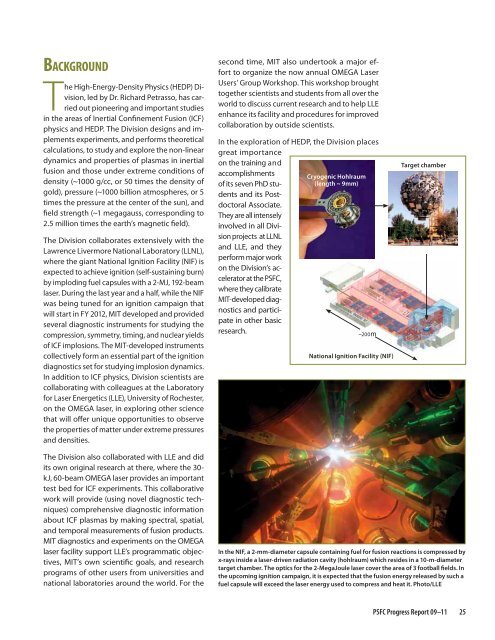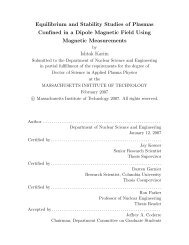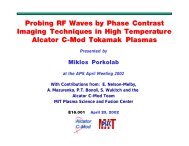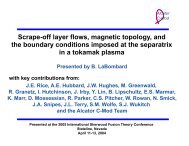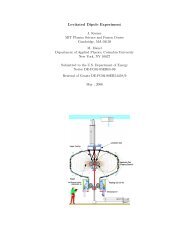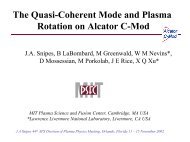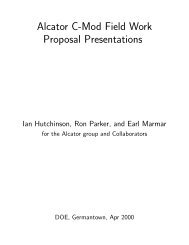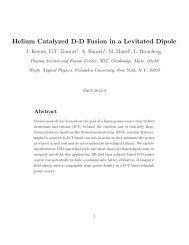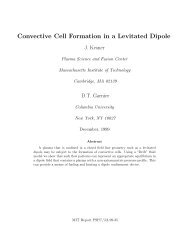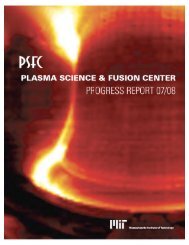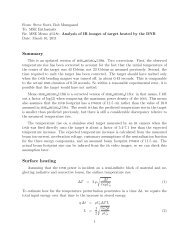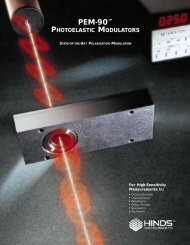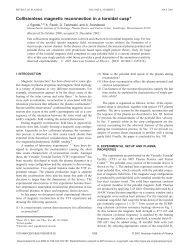Download a copy of the latest PSFC Progress Report - Plasma ...
Download a copy of the latest PSFC Progress Report - Plasma ...
Download a copy of the latest PSFC Progress Report - Plasma ...
Create successful ePaper yourself
Turn your PDF publications into a flip-book with our unique Google optimized e-Paper software.
Background<br />
The High-Energy-Density Physics (HEDP) Division,<br />
led by Dr. Richard Petrasso, has carried<br />
out pioneering and important studies<br />
in <strong>the</strong> areas <strong>of</strong> Inertial Confinement Fusion (ICF)<br />
physics and HEDP. The Division designs and implements<br />
experiments, and performs <strong>the</strong>oretical<br />
calculations, to study and explore <strong>the</strong> non-linear<br />
dynamics and properties <strong>of</strong> plasmas in inertial<br />
fusion and those under extreme conditions <strong>of</strong><br />
density (~1000 g/cc, or 50 times <strong>the</strong> density <strong>of</strong><br />
gold), pressure (~1000 billion atmospheres, or 5<br />
times <strong>the</strong> pressure at <strong>the</strong> center <strong>of</strong> <strong>the</strong> sun), and<br />
field strength (~1 megagauss, corresponding to<br />
2.5 million times <strong>the</strong> earth’s magnetic field).<br />
The Division collaborates extensively with <strong>the</strong><br />
Lawrence Livermore National Laboratory (LLNL),<br />
where <strong>the</strong> giant National Ignition Facility (NIF) is<br />
expected to achieve ignition (self-sustaining burn)<br />
by imploding fuel capsules with a 2-MJ, 192-beam<br />
laser. During <strong>the</strong> last year and a half, while <strong>the</strong> NIF<br />
was being tuned for an ignition campaign that<br />
will start in FY 2012, MIT developed and provided<br />
several diagnostic instruments for studying <strong>the</strong><br />
compression, symmetry, timing, and nuclear yields<br />
<strong>of</strong> ICF implosions. The MIT-developed instruments<br />
collectively form an essential part <strong>of</strong> <strong>the</strong> ignition<br />
diagnostics set for studying implosion dynamics.<br />
In addition to ICF physics, Division scientists are<br />
collaborating with colleagues at <strong>the</strong> Laboratory<br />
for Laser Energetics (LLE), University <strong>of</strong> Rochester,<br />
on <strong>the</strong> OMEGA laser, in exploring o<strong>the</strong>r science<br />
that will <strong>of</strong>fer unique opportunities to observe<br />
<strong>the</strong> properties <strong>of</strong> matter under extreme pressures<br />
and densities.<br />
second time, MIT also undertook a major effort<br />
to organize <strong>the</strong> now annual OMEGA Laser<br />
Users’ Group Workshop. This workshop brought<br />
toge<strong>the</strong>r scientists and students from all over <strong>the</strong><br />
world to discuss current research and to help LLE<br />
enhance its facility and procedures for improved<br />
collaboration by outside scientists.<br />
In <strong>the</strong> exploration <strong>of</strong> HEDP, <strong>the</strong> Division places<br />
great importance<br />
on <strong>the</strong> training and<br />
accomplishments<br />
<strong>of</strong> its seven PhD students<br />
and its Postdoctoral<br />
Associate.<br />
They are all intensely<br />
involved in all Division<br />
projects at LLNL<br />
and LLE, and <strong>the</strong>y<br />
perform major work<br />
on <strong>the</strong> Division’s accelerator<br />
at <strong>the</strong> <strong>PSFC</strong>,<br />
where <strong>the</strong>y calibrate<br />
MIT-developed diagnostics<br />
and participate<br />
in o<strong>the</strong>r basic<br />
research.<br />
Cryogenic Hohlraum<br />
(length ~ 9mm)<br />
~200m<br />
National Ignition Facility (NIF)<br />
Target chamber<br />
The Division also collaborated with LLE and did<br />
its own original research at <strong>the</strong>re, where <strong>the</strong> 30-<br />
kJ, 60-beam OMEGA laser provides an important<br />
test bed for ICF experiments. This collaborative<br />
work will provide (using novel diagnostic techniques)<br />
comprehensive diagnostic information<br />
about ICF plasmas by making spectral, spatial,<br />
and temporal measurements <strong>of</strong> fusion products.<br />
MIT diagnostics and experiments on <strong>the</strong> OMEGA<br />
laser facility support LLE’s programmatic objectives,<br />
MIT’s own scientific goals, and research<br />
programs <strong>of</strong> o<strong>the</strong>r users from universities and<br />
national laboratories around <strong>the</strong> world. For <strong>the</strong><br />
In <strong>the</strong> NIF, a 2-mm-diameter capsule containing fuel for fusion reactions is compressed by<br />
x-rays inside a laser-driven radiation cavity (hohlraum) which resides in a 10-m-diameter<br />
target chamber. The optics for <strong>the</strong> 2-MegaJoule laser cover <strong>the</strong> area <strong>of</strong> 3 football fields. In<br />
<strong>the</strong> upcoming ignition campaign, it is expected that <strong>the</strong> fusion energy released by such a<br />
fuel capsule will exceed <strong>the</strong> laser energy used to compress and heat it. Photo/LLE<br />
<strong>PSFC</strong> <strong>Progress</strong> <strong>Report</strong> 09–11 25


